Open Access, Peer-reviewed
eISSN 2093-9752

Open Access, Peer-reviewed
eISSN 2093-9752
Chang-Yei Back
Ji-Yong Joo
Young-Kwan Kim
http://dx.doi.org/10.5103/KJSB.2016.26.1.39 Epub 2016 April 20
Abstract
The purposes of this study were to compare the kinematics of a two-arm kettlebell swing between experts and beginners and to identify the correct postures and biomechanical key points in an attempt to prevent sports injuries induced by a kettlebell swing.
Four experts (height, 169.7 ± 1.5 cm; weight, 70.5 ± 1.8 kg; age, 32.0 ± 1.0 years) licensed to teach kettlebell exercises and three beginners (height, 173.7 ± 4.1 cm; weight, 78.3 ± 3.8 kg; age, 30.0 ± 1.4 years) with no kettlebell exercise experience participated in this study. Each participant performed 15 repetitions of a two-arm kettlebell swing using a 16-kg weight. Joint angles, angular velocities, and peak angular velocity sequences were calculated and compared between the two groups.
Large ranges of motion (ROM) of the pelvic angle and hip joints were detected in the experts, while beginners showed greater ROM of the shoulder joint. Peak angular velocity magnitudes and sequences were significantly different between the two groups. Experts lifted the kettlebell upward using the hip joints, pelvis, and shoulder joints (proximal to distal order) sequentially and lowered it using the reverse order of peak angular velocities from the shoulder to hip joints.
Mobility of the pelvic segment and hip joint are required, while stability of the other joints is needed to produce appropriate two-arm kettlebell swings. The activation and coordination of the gluteal and hamstring muscles are key points in kettlebell exercises.
Keywords
Two-arm kettlebell swing Kinematics Multi-joint coordination Pelvis Hip
Kettlebell training is a new type of functional training to improve athletic performance in athletes. Interest in kettlebells increased in Western society when Soviet weight- lifters who trained using kettlebell training achieved good results in international meets (Jung, Kang, & Choi, 2010).
Kettlebell training has several unique characteristics. The shape of kettlebells makes them comfortable to hold at the center of the body and swing. In kettlebell training, the shape of the kettlebells is used to perform efficient and dynamic swing or snatch movements. In a kettlebell swing, the weights are raised in front of the body with the movement depending less on flexion and extension of the elbow joint, but rather on mobility of the major syn- ergistic muscles and joints of the core, with the core in a stabilized state (McGill & Marshall, 2012). In particular, when performing kettlebell swings, the kettlebells constantly try to move outward due to centrifugal force, so the body experiences a greater load even with the same weight. One advantage is that it is possible to train the whole body and achieve both anaerobic and aerobic training using only kettlebells (Jay et al., 2011; Schnettler, Porcari, Foster, & Anders, 2010). Moreover, the exercises can easily be performed even in a confined space, and it is possible to coordinate training between the core muscles and the extremities (Jung et al., 2010).
Looking at the mechanism for kettlebell swings, since they demand little movement of the knees and dynamic movement of the pelvis and hip joints, they are useful for training the gluteal muscles and function. Kettlebell training is considered an alternative training method, replacing the classic gluteal training exercises such as squats and deadlifts (Matthews, Cohen, 2013; McGill & Marshall, 2012). Further- more, Zebis et al. (2013) reported that kettlebell swings activated the medial hamstrings more than other strength training. Studies examining ground reaction force (GRF) showed that kettlebell swings produced a larger GRF than squats or jump squats. As a result, kettlebell swings are known to be a suitable training method for short-distance sprinters, who require explosive propulsion in the medial hamstrings and a strong horizontal GRF (Cronin, Keogh, Randell, & Gill, 2010; Lake & Lauder, 2012a).
Since kettlebell swings involve repeated lifting of a heavy weight, there are many risks of sports injury. Tsatsouline advised kettlebell users not to bend the wrist and to maintain a neutral spine and shoulder position during ket- tlebell swings in order to produce an efficient movement without injury (Tsatsouline, 2006). Beginners in kettlebell swings are instructed to transfer elastic energy to the kettlebell via the stretch reflex of the hamstrings and gluteal muscles. When the kettlebell falls, to create a load on the hip-hinge and transfer the elastic energy stored in the gluteal regions to the kettlebell, the swing must be per- formed with the erected spine and shoulder joints in neutral position. This posture is designed to control the invisible exchange of forces between the body and the kettlebell efficiently and to maximize the training effect (Tsatsouline, 2006). However, because the position of the kettlebell changes continuously throughout the swinging motion, it is practically difficult to maintain this neutral position. As a result, knee and lower back injuries are com- mon in individuals who have not been properly trained in the movements and who simply begin kettlebell training out of interest (Health Chosun, 2015). This because be-ginners use the knees, lower back, and wrists to lift the kettlebells. In other words, beginners suffer difficulty in utilizing gluteus and hamstrings because they are not familiar with activating those muscles.
Therefore, people learning kettlebell swings must be provided with basic knowledge about the mechanics of the kettlebell motion. It is important to avoid injury by con- centrating on performing correct movements and avoiding thoughtless movements. Hence, this study aimed to pro-vide educational information to prevent injury and to compare kettlebell swings in beginners and experts from a kinematic perspective, thereby revealing the proper pos- ture for kettlebell swings and the key factors that can improve efficiency.
1. Subjects
The subjects for this study consisted of three beginners with no experience of kettlebell swings and no musculo- skeletal disease as well as four experts with a Level 1 instructor's certificate (STRONG FIRST GYRIA, SFG) in kettlebell training who were currently teaching kettlebell swings to people. The purposes and procedures of this study were thoroughly explained to all subjects, and written consent forms were signed prior to the experiment. Table 1 shows the subjects' physical characteristics.
|
Subject |
Height (cm) |
Weight (kg) |
Age (years) |
|
Expert (n=4) |
169.75 ± 1.48 |
70.50 ± 1.80 |
32.00 ± 1.00 |
|
Beginner (n=3) |
173.67 ± 4.19 |
78.33 ± 3.86 |
30.00 ± 1.41 |
2. Experimental apparatus
The experimental and analytical apparatus used in this experiment consisted of five high-speed infrared cameras (Osprey®, Motion Analysis, Santa Rosa, CA, USA) and software to operate these cameras (Cortex® 4.0, Motion Analysis). The sampling rate of the cameras was 120 Hz, and 17 19-mm reflective markers were attached to major anatomical points for motion capture.
The major anatomical landmarks included the right 2nd metatarsal phalangeal joint, middle of the calcaneus, lateral malleolus, lateral condyle, third metacarpal phalangeal joint, greater trochanter, middle of the styloid processes, and lateral epicondyle as well as the bilateral acromion pro-cesses and anterior superior iliac spines. Anteriorly and posteriorly, markers were also affixed to the middle of the posterior superior iliac spine, sternal notch, cervical 7 spinous process, anterior kettlebell, and posterior kettlebell. Because movements of the arms and legs could be con- sidered symmetry, the movement was assumed two-dimensional movement in the sagittal plane, and markers were only placed on the right side. Subjects had uncovered upper bodies wore wearing tight-fitting swimming pants during the experiment (Figure 1).
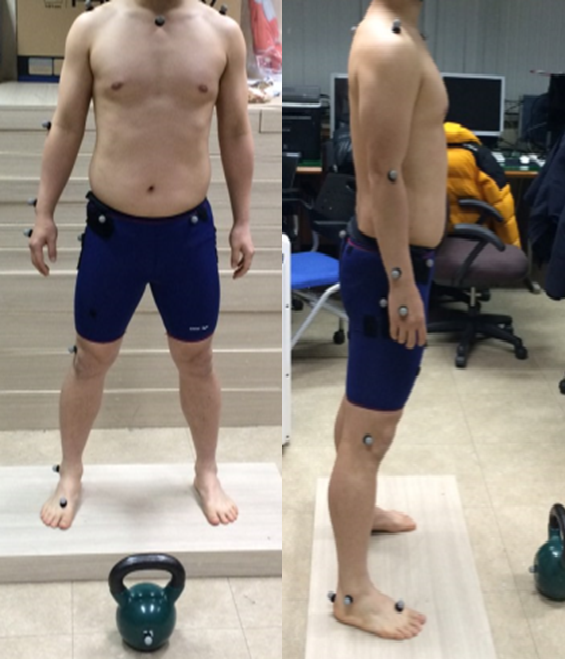
3. Experimental procedures
First, the objectives, procedure, and measuring methods used in the study were explained to the subjects. Prior to the kettlebell swings, the subjects performed sufficient warm-up exercises and stretching. With the kettlebells placed on the ground, subjects were first instructed to tilt the kettlebells while pulling them backward so that the body's center of gravity was shifted posteriorly before taking up the first position (E1). They were then instructed to rapidly and forcefully swing the kettlebells upward as if throwing them forward and allow the hand to naturally follow the kettlebells when bringing them back down. For the grip, subjects were told to keep the wrist in a neutral position without changing its angle and hold the kettlebells side by side as if trying to snap a stick. A standard 16-kg kettlebell was used according to the SFG guideline, because this is the normal weight for adult male beginners. Fol- lowing this, the subjects performed 15 consecutive two-arm kettlebell swings according to the examiner's instruc- tions. The selection of 15 repetitions was based on the study of Mullineauz, Bartlett, and Bennett (2001).
After the measured data were downloaded to a com-puter for analysis, the commercial numerical analysis pro-gram Matlab® (version 2009, MathWorks, USA) was used for post-processing of the data. Before the biomechanical parameters were calculated, the movement data were smoothed by the application of a Butterworth low-pass filter with a cut-off frequency of 8 Hz. The kettlebell swing movement was divided into the following five events and four phases for easy understanding of the motion (Figure 2).
4. Analytical methods
1) Events
① E1: When the kettlebell is at the most posterior pos- ition relative to the body
② E2: When the kettlebell reaches peak linear velocity during the upward swing
③ E3: When the kettlebell reaches the highest vertical height
④ E4: When the kettlebell reaches peak linear velocity during the downward swing
⑤ E5: When the kettlebell is at the most posterior pos- ition relative to the body (same as E1)
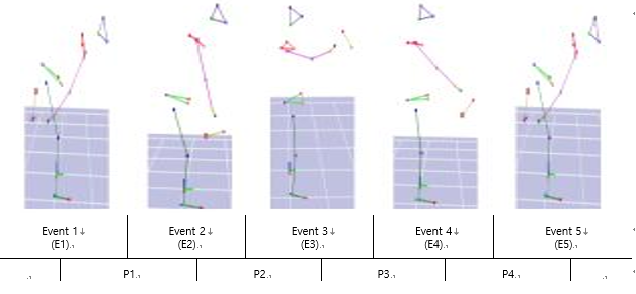
2) Phases
① P1 (E1-E2): The elevation and acceleration phase of the kettlebell
② P2 (E2-E3): The elevation and deceleration phase of the kettlebell
③ P3 (E3-E4): The descent and acceleration phase of the kettlebell
④ P4 (E4-E5): The descent and deceleration phase of the kettlebell
3) Joint angles and segment angle
The ankle angle is defined as the cosine angle between the lower leg and the foot segments, the knee angle is between the thigh and the lower leg, and the hip angle is between the trunk segment (the line connecting the hip joint and the shoulder joint) and the thigh segment. The pelvic segment angle is the relative angle between the global horizontal plane and the normal vector of the pelvic plane composed of the anterior superior iliac spines and the posterior superior iliac spines. In the arm, the wrist angle is the cosine angle between the longitudinal axis of the forearm and the longitudinal axis of the hand segment, while the elbow is between the longitudinal axis of the upper arm and that of the forearm. The shoulder angle is the cosine angle between the vertical axis of the trunk segment and the longitudinal axis of the upper arm (Figure 3).
5. Statistical analysis
The mean values from 15 repetitions were defined as the representative values for each subject. For statistical testing, the nonparametric Mann-Whitney U test was per-formed on these representative values with a significance level of .05. The values displayed in the graphs are the ensemble average of each subject's data.
1. Analysis of angular motions
1) Qualitative analysis of joint angles and seg- ment angle
Figure 4 shows a comparison of qualitative joint angles and segment angle for experts and beginners during two¬arm kettlebell swings. The graphs are plots of the ensem-ble averages obtained for experts (n = 4) and beginners (n = 3), respectively. The x-axis represents normalized time from E1 (0%) to E5 (100%), while the y-axis represents the change in angle over time.
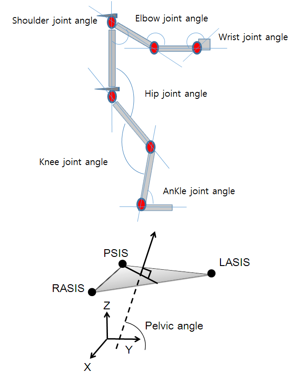
Regarding the changes in angle for each joint, the pelvic segment angle differed between the two groups in the mid-to-late phases of the movement. The hip and knee angles differed between experts and beginners in the angle at peak angular velocity and during descent phase. The ankle and shoulder joint angles were larger at peak angular velocity for the beginners than for the experts. Meanwhile, there were no clear differences between the two groups in elbow and wrist angles.
2) Quantitative analysis of joint angles and segment angle
Table 2 displays the mean values for the maximum, minimum, and ROM measured during the repeated move- ments. The difference (Δ) between the two groups is dis-played relative to the beginner values. Regarding the ROM for each joint, there were significant inter-group differences for the shoulder and hip joints, respectively (p < .05). For the shoulder joint, the ROM for beginners (72.66°) was 19.09° larger than that of the experts (53.57°), a significant difference (p < .05). Conversely, for the hip joint, the ROM for the experts (99.75°) was 19.87° larger than that of the beginners (79.88°), which was also significant (p < .05). Although there was no significant difference in pelvic angle, the experts' ROM was 11.57° larger than that of the be- ginners.
3) Quantitative analysis of angles in terms of the event
Table 3 displays the means and standard deviations for segment angle and joint angles of the experts and be- ginners at different events. Regarding the differences in joint angle between the beginners and experts for each event, the hip, knee, and shoulder joints showed significant differences in only some events (p < .05). The hip joint showed a significant difference when the kettlebells reached their peak vertical height (E3), and the knee joint showed a significant difference at peak downward angular velocity (E4) (p < .05). The shoulder joint showed a significant difference from peak upward angular velocity (E2) to peak downward angular velocity (E4) (p < .05). Beginners (52.72°, 100.25°, and 63.16°) showed larger shoulder joint angles than experts (38.85°, 76.99°, and 35.08°) from E2 to E4. In particular, the shoulder joint angle for beginners at E3 was 23.36° larger than that of experts. Although pelvic segment angle showed no significant difference between the two groups, the pelvis was more extended for the experts than for the beginners, from E2 to E5.
2. Analysis of angular velocity
1) Qualitative analysis of angular velocities
Figure 5 shows a comparison between beginners and experts of qualitative angular velocities during kettlebell two-arm swings. The x-axis represents normalized time from E1 (0%) to E5 (100%), and the y-axis represents the change in velocity.
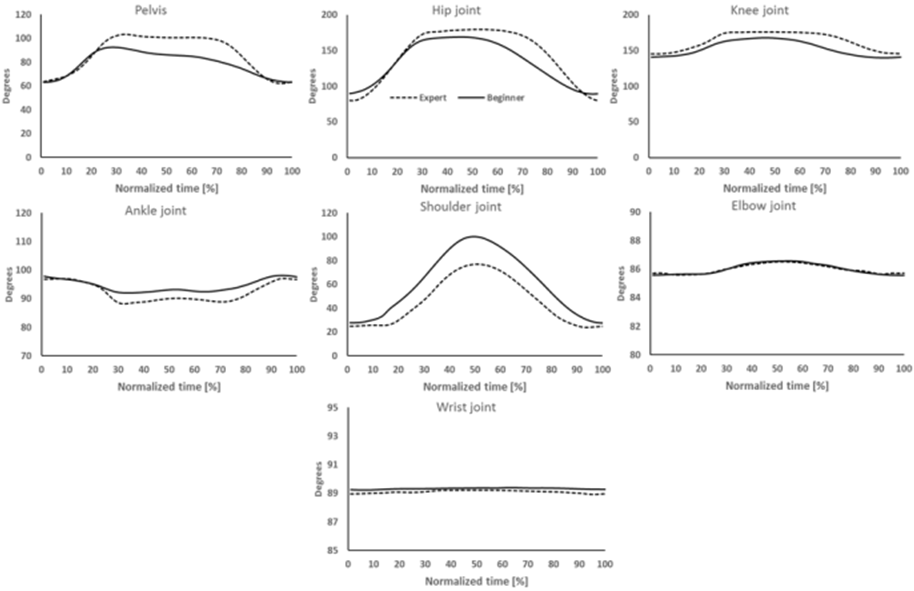
Regarding changes in angular velocity, experts showed a larger magnitude of maximum angular velocity during elevation and minimum angular velocity during descent in the leg joints (hip, knee, and ankle) and in pelvic seg- ment angle. There was also some difference in the timing of maximum and minimum angular velocities. There was no clear difference between the two groups in angular velocities of the arm joints (shoulder, elbow, and wrist).
2) Differences in the magnitude of angular velocity
Table 4 displays the mean values for the maximum, minimum, and ranges for angular velocities. Relative to the absolute values for beginners, the largest differences between the two groups in velocity range (maximum - minimum) were found in the hip joint (223.8°/s), followed by the pelvic angle (157.1°/s) and then the knee joint (67.7°/s).
The joints or segments showing a statistically significant difference were the pelvic, hip joint, and wrist joint (p < .05). Although the wrist joint showed a statistically significant difference between the two groups, the absolute range was very small (5°/s).
3. Comparison of multi-joint coordination
1) Timing of maximum and minimum angular velocities
As shown in Figure 6, multi-joint coordination during two-arm kettlebell swings was compared between experts and beginners based on the timing of maximum and minimum angular velocities. When raising the kettlebell (E1 to E3), the experts showed maximum joint angular velocities first in the hip joint (19%), followed by the pelvic segment (21%) and then the shoulder joint (34%). Con-versely, when lowering the kettlebell (E3 to E5), they showed minimum joint angular velocities in the reverse order, starting with the shoulder joint (78%), followed by the pelvic segment (82%) and then the hip joint (85%). Beginners showed a different pattern, with an order for maximum angular velocities during kettlebell elevation (E1 to E3) of pelvic segment (16%), hip joint (19%), and shoul- der joint (32%) and an order for minimum angular velocity during descent (E3 to E5) of hip joint (75%), shoulder joint (78%), and pelvic segment (83%).
|
Joint |
Export |
Beginner |
Δ |
p |
|
|
Pelvis |
Max |
104.0 |
92.99 |
11.01 |
.480 |
|
Min |
61.64 |
62.54 |
-0.9 |
.724 |
|
|
ROM |
42.01 |
30.44 |
11.57 |
.157 |
|
|
Hip |
Max |
179.5 |
168.8 |
10.7* |
.034 |
|
Min |
79.75 |
88.95 |
-9.2 |
.157 |
|
|
ROM |
99.75 |
79.88 |
19.87* |
.034 |
|
|
Knee |
Max |
176.7 |
169.0 |
7.7 |
.480 |
|
Min |
143.8 |
134.5 |
9.3 |
.157 |
|
|
ROM |
32.84 |
34.47 |
-1.63 |
.724 |
|
|
Ankle |
Max |
98.57 |
103.2 |
-4.63 |
.480 |
|
Min |
87.76 |
86.83 |
0.93 |
1.0 |
|
|
ROM |
10.80 |
16.36 |
-5.56 |
.289 |
|
|
Shoulder |
Max |
76.98 |
100.3 |
-23.32* |
.034 |
|
Min |
23.41 |
27.59 |
-4.18 |
.157 |
|
|
ROM |
53.57 |
72.66 |
-19.09* |
.034 |
|
|
Elbow |
Max |
86.61 |
86.59 |
0.02 |
.724 |
|
Min |
85.57 |
85.46 |
0.11 |
.480 |
|
|
ROM |
1.04 |
1.13 |
-0.09 |
.724 |
|
|
Wrist |
Max |
89.21 |
89.41 |
-0.2 |
.289 |
|
Min |
88.89 |
89.20 |
-0.31 |
.157 |
|
|
ROM |
0.35 |
0.21 |
0.14 |
.157 |
This study compared two-arm kettlebell swings in be-ginners and experts with the aim of providing important biomechanical information to enhance kettlebell swings efficiency and minimize injuries.
On the basis of the results of qualitative graphs and the quantitative analysis, a clear difference between experts and beginners was detected at the motions of the pelvic segment, hip joint, and shoulder joint. During kettlebell swings, subjects are instructed to pull the shoulder joint posteriorly and inferiorly (Tsatsouline, 2006). This posture aims to control the centrifugal force effectively that is generated when moving the kettlebells in angular trajec-tories. When performing kettlebell swings in this way, it is important to stabilize the shoulder joint and minimize its joint ROM. Since the experts were able to do this effec- tively, their ROM of the shoulder was 19° smaller than that of the beginners. The reduced shoulder joint ROM was compensated by extensions of other joints and segments— specifically, the hip joint and the pelvic segment. Com-pared to beginners, the experts showed a 19.87° larger ROM for the hip joint and an 11.57° larger ROM for the pelvis, showing that they used the hip joint and pelvic segment rather than the shoulder joint to generate the swing impulse.
Cook (2012) showed that, in movements involving multiple segments of the body, segments that require stability move less. The results of this study suggest that the shoulder joint requires stability. In actual kettlebell training practice, instruction should be provided for control and maintenance of shoulder joint alignment as well as a swing posture that allows coordination of different seg-ments of the body. The fact that experts showed a larger pelvic ROM than beginners suggests that the experts were actively using their pelvises during the kettlebell swings. If kettlebell swings are performed without sufficient pelvic ROM, it could have a negative effect on soft tissues around the pelvis. In this case, compensatory actions in the sur-rounding soft tissue and the accumulated effect of ineffi- cient movements could lead to pain and/or injury (Micheal, Scott, & Brian, 2010). Other studies have also shown that as the kettlebell moves farther from the body's center of mass, the centrifugal force tends to make the kettlebell slip out of the hands, which indicates that kettlebell exercise places a greater work-load on the body than other ex- ercises does with the same weight. To actively counteract this shift in forces, sufficient core stability and mobility of specific segments (i.e., the hip joint and pelvis) are required (McGill & Marshall, 2012). In particular, when beginners learn kettlebell swings, they should be instructed to discri- minate mobile segments from stable segment. Repeated practices to demonstrate the proper sensory perception as well as internal and external feedback should be given to beginners. If these conditions are well satisfied, efficient kettlebell swings should be established.
|
Joint |
Subject |
E1 |
E2 |
E3 |
E4 |
E5 |
|
Pelvis |
Export |
63.44 ± 4.05 |
96.97 ± 5.77 |
100.50 ± 4.35 |
84.09 ± 6.03 |
63.45 ± 4.76 |
|
Beginner |
63.19 ± 7.64 |
91.36 ± 19.53 |
86.38 ± 14.23 |
78.14 ± 13.28 |
63.26 ± 8.51 |
|
|
p |
.724 |
.480 |
.289 |
.476 |
.724 |
|
|
Hip |
Export |
80.13 ± 3.52 |
159.06 ± 11.92 |
179.41 ± 5.10 |
143.34 ± 9.67 |
80.00 ± 3.64 |
|
Beginner |
89.87 ± 10.26 |
151.05 ± 8.89 |
168.38 ± 6.55 |
127.58 ± 9.98 |
89.46 ± 3.64 |
|
|
p |
.157 |
.480 |
.034* |
.077 |
.157 |
|
|
Knee |
Export |
144.97 ± 5.46 |
166.17 ± 8.11 |
175.92 ± 3.63 |
161.21 ± 6.36 |
145.19 ± 5.44 |
|
Beginner |
140.54 ± 12.89 |
155.98 ± 15.11 |
167.44 ± 15.58 |
147.31 ± 5.02 |
140.64 ± 12.90 |
|
|
p |
.724 |
.289 |
.480 |
.034* |
1.0 |
|
|
Ankle |
Export |
96.86 ± 4.44 |
91.81 ± 4.07 |
90.13 ± 5.19 |
91.51 ± 3.86 |
96.74 ± 4.39 |
|
Beginner |
97.84 ± 6.07 |
93.77 ± 14.50 |
93.09 ± 14.57 |
93.99 ± 5.59 |
97.66 ± 6.22 |
|
|
p |
1.0 |
.724 |
1.0 |
.285 |
1.0 |
|
|
Shoulder |
Export |
20.59 ± 4.11 |
38.85 ± 2.27 |
76.99 ± 5.45 |
35.08 ± 2.83 |
24.88 ± 4.20 |
|
Beginner |
27.88 ± 1.21 |
52.72±2.77 |
100.25 ± 2.59 |
63.16 ± 3.53 |
27.61 ± 1.31 |
|
|
p |
.289 |
.034* |
.034* |
.032* |
.289 |
|
|
Elbow |
Export |
85.73 ± 0.30 |
85.84 ± 0.25 |
86.54 ± 0.38 |
85.93 ± 0.40 |
85.74 ± 0.30 |
|
Beginner |
85.58 ± 0.89 |
85.73 ± 0.48 |
86.56 ± 0.57 |
86.05 ± 0.49 |
85.58 ± 0.89 |
|
|
p |
.471 |
.593 |
.724 |
.724 |
.476 |
|
|
Wrist |
Export |
88.95 ± 0.15 |
89.06 ± 0.09 |
89.22 ± 0.09 |
89.10 ± 0.08 |
88.96 ± 0.14 |
|
Beginner |
89.25 ± 0.28 |
89.32 ± 0.20 |
89.36 ± 0.24 |
89.37 ± 0.19 |
89.28 ± 0.30 |
|
|
p |
.203 |
.064 |
.364 |
.064 |
.208 |
When differences between experts and beginners in joint and segment angles were examined at each event, the pelvis and hip joint were largely related to mobility, while the other joints each showed a very small ROM and can be considered to contribute to stability. Since the shoulder joint has large ROM, it could be considered a mobility joint. It, however, should be seen as a stability joint because minimizing shoulder ROM is required for proper kettlebell swings.
Regarding segment and joint angular velocities for ex- perts and beginners, there were significant inter-group differences in the hip joint, pelvic segment, and wrist joint. Although the knee and shoulder joints showed large absolute values for maximum and minimum angular velo- cities, the differences between the two groups were smaller compared to those for the hip joint and the pelvis. This shows that the hip joint and the pelvis, which are proximal joint and segment, are the major contributing mobility joints that transfer their kinetic energy to the distal seg- ments. In particular, the shapes of the pelvis and hip angular velocity graphs for the experts show a negative maximum angular acceleration (a negative gradient for the angular velocity graph) at P2 and a positive maximum angular acceleration (a positive gradient for the angular velocity graph) at P4. P2 and P4 can be considered intervals of gluteal and hamstring activations through eccentric con- traction. In other words, kettlebell swings, predominantly using activation of the hip joint and pelvis, could be useful for improving muscle contraction speed in specific inter- vals of sporting situations, and in developing the stretch-shortening cycle (Kim, Yoon, & Seo, 2005; Zebis et al., 2013). This is because kettlebell swings place greater focus on eccentric control of the hamstrings, and they are able to generate faster contraction speeds in the hamstrings than other conventional exercises. Thus, kettlebell swings are thought to be an essential conditioning program in sports that require explosive propulsion in minimal time, such as soccer, baseball, basketball, and other athletics. Meanwhile, beginners have difficulty with the timing in certain intervals due to a lack of basic physical conditioning, including muscle strength and coordination of motor functions. As a result, it is essential to first train the multi-joint movement involved in kettlebell swings using only a lightweight or no weight at all until acquiring proper activation timing of the gluteal muscles and then gradually increase the weight with practice.
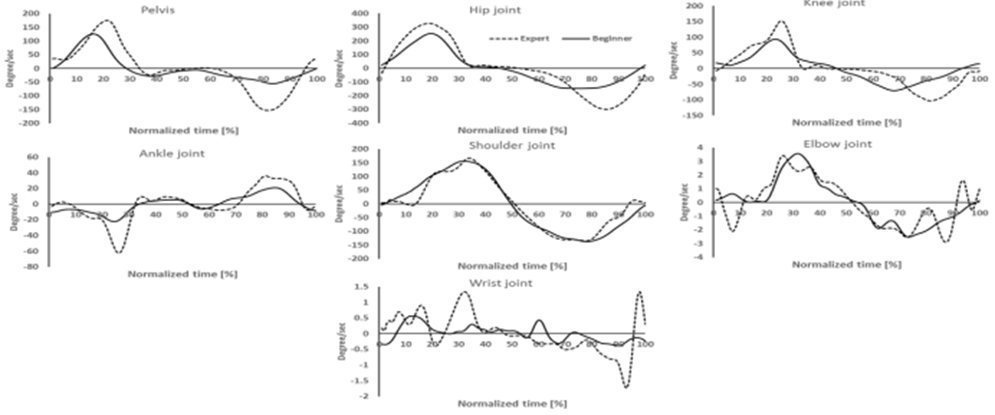
Looking at patterns of multi-joint coordination, experts showed maximum activation (timing of maximum angular velocity) in an order of the activation of the hip joint, pelvis, and shoulder joint during kettlebell elevation (E1 to E3). In other words, kinetic energy transfer progressed from the proximal segment to the distal segment, which is the proper kinetic sequence for open kinetic chain movements (Kim, 2014; Yoon & Chae, 2008). However, during kettlebell elevation in beginners, the order of hip joint and pelvis activation changed. During kettlebell descent (E3 to E5), experts showed activation in the reverse order to elevation: shoulder joint, pelvis, and hip joint. Conversely, for begin- ners, the order during descent was hip joint, shoulder joint, and pelvis, which showed no relation to the order during elevation. This is likely due to a lack of muscle strength, mobility, and coordination in the hip joint and pelvis for beginners. In other words, because the movements of the hip joint and pelvis were insufficient, there was a clear difference with the experts in the maximum and minimum angular velocities for these joints.
During kettlebell swings, it is important to use the hip joint and pelvis to transfer kinetic energy travelling up the leg from the GRF toward the distal segments. To this end, activation of the gluteus maximus and hamstrings is very important. In a study by Cho (2015) examining core muscle activation during three different hip drive exercises, ket- tlebell swings showed higher gluteus maximus activation than squats or deadlifts did. In addition, a study by Zebis et al. (2013) comparing hamstring activation for kettlebell swings with leg curls showed more activation in kettlebell swings, and the authors reported that this could lead to improvements in hamstring strengthening and hypertrophy with large flexion angles. Thus, the literature shows a close correlation between the gluteus maximus and hamstring with movements of the hip joint and pelvis, which is con- sistent with the results of the present study. Lake and Lauder (2012b) stated that it was important to maintain the erected spine posture when the kettlebell is at the lowest point of the swing, and this is only possible when the movement is supported by the strength of the gluteus maximus.
|
Variable |
Range |
Export |
Beginner |
Δ |
p |
|
Pelvis |
Max |
183.2 |
132.7 |
50.5 |
.289 |
|
Min |
-166.2 |
-59.7 |
106.5* |
.034 |
|
|
Diff |
349.4 |
192.3 |
157.1* |
.034 |
|
|
Hip |
Max |
329.9 |
255.7 |
74.2* |
.034 |
|
Min |
-305.7 |
-155.9 |
149.1* |
.034 |
|
|
Diff |
635.5 |
411.7 |
223.8* |
.034 |
|
|
Knee |
Max |
158.5 |
103.9 |
54.6 |
.077 |
|
Min |
-116.4 |
-103.3 |
13.1 |
.480 |
|
|
Diff |
274.9 |
207.2 |
67.7 |
.289 |
|
|
Ankle |
Max |
47.3 |
47.8 |
-0.5 |
.724 |
|
Min |
-65.9 |
-52.1 |
13.8 |
.289 |
|
|
Diff |
113.2 |
99.9 |
13.3 |
.724 |
|
|
Shoulder |
Max |
169.1 |
157.0 |
12.1 |
.480 |
|
Min |
-142.3 |
-142.2 |
0.1 |
1.0 |
|
|
Diff |
311.4 |
299.2 |
12.2 |
.724 |
|
|
Elbow |
Max |
4.4 |
3.6 |
0.8 |
.289 |
|
Min |
-5.1 |
-3.2 |
1.9 |
.157 |
|
|
Diff |
9.5 |
6.8 |
2.7 |
.077 |
|
|
Wrist |
Max |
2.6 |
1.0 |
1.6* |
.034 |
|
Min |
-2.3 |
-0.9 |
1.3* |
.034 |
|
|
Diff |
4.9 |
2.0 |
2.9* |
.034 |
Combining the above results, hip joint and pelvic mobility as well as stability of the remaining joints are important to perform kettlebell swings efficiently and minimize injury. Patterns of coordination during kettlebell swings show that the order of activation and transfer of energy when raising the kettlebells to their highest point should go from the hip joint to the pelvis to the shoulder joint. Conversely, when lowering the kettlebells and returning to the start position, the order of joint activation should go from the shoulder joint to the pelvis to the hip joint. The results of this study demonstrate that it is important to control basic mobility and stability during kettlebell swings as well as body alignment, muscular contraction timing, and force shifts. Before starting a high difficulty movement like ket- tlebell swings, it is essential to first receive specific training (e.g. gluteal activation exercises) in order to facilitate skill acquisition efficiency and prevent injury. One limitation of this study is the small number of subjects relative to the broad spectrum of potential subjects, which restricts gene- ralization of its results. In the future, broader studies will be required that use electromyography and GRF to effi- ciently measure changes in force during kettlebell swings.
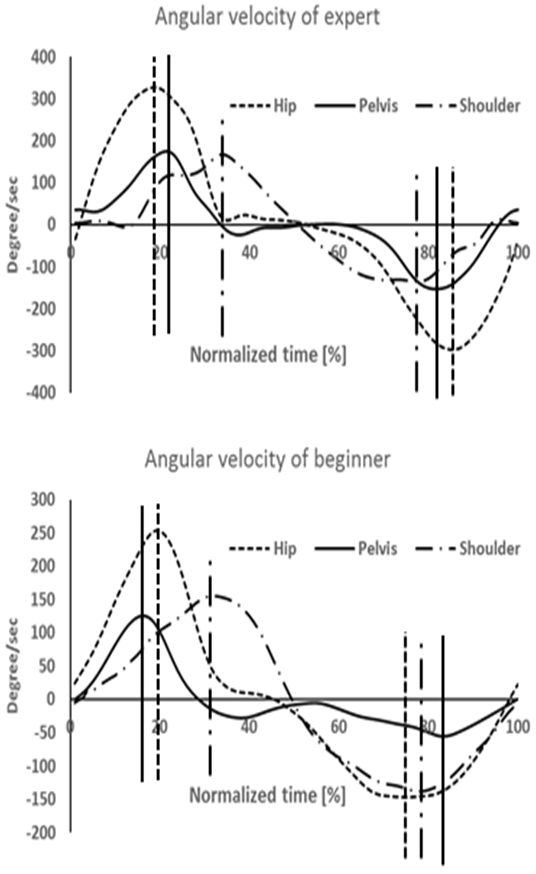
This study compared biomechanical variables during two-arm kettlebell swings in experts and beginners with the aim of elucidating the proper kettlebell swing posture. The following conclusions were made based on the results.
First, there were clear differences between experts and beginners in the movements of the hip joint, pelvis, and shoulder joint. Experts utilized a larger ROM for the hip joint and pelvis to perform kettlebell swings, while begin- ners utilized the shoulder joint ROM to compensate for insufficient ROM of the hip joint and pelvis.
Second, differences between experts and beginners in actual joint and segmental angular velocities also appeared in the hip joint and pelvis. The experts showed a greater angular velocity compared to the beginners. Thus, the hip joint and pelvis can be considered a mobility joint and segment, respectively.
Third, during kettlebell elevation, the experts showed activation in the order of hip joint, pelvis, and shoulder joint, whereas beginners did not show efficient multi-joint coordination.
In conclusion, kettlebell swings are a movement for which hip joint and pelvic mobility are essential, while stability should be maintained in other joints, including the shoulder. To this end, activation and coordination of the gluteal muscles and the hamstrings are important. If pre-training for stimulating the gluteal muscles and ham- strings is performed properly, it could reduce injuries and help produce ideal kettlebell movement.
References
1. Cho, W. R. (2015). Comparison of core muscle activation during three hip drive motion exercise. Unpublished master thesis. Korea National Sport University. Seoul, Korea.
2. Cook, G. (2012). Movement: Functional movement systems, Washington, D.C.: On Target Publications.
Crossref
Google Scholar
3. Health chosun (2015). Health chosun press release. (http://health.chosun.com/site/data/html_dir/2015/06/19/2015061900834.html.).
4. Jay, K., Frisch, D., Hansen, K., Zebis, M. K., Andersen, C. H., Mortensen, O. S. & Andersen, L. L. (2011). Kettlebell training for musculoskeletal and cardiovascular health: A randomized controlled trial. Environ & Health, 37(3), 196-203.
Crossref
Google Scholar
PubMed
5. Jung, G., Kang, S. & Choi, H. (2010). Kettlebell quick result. Seoul: Wisdom House.
6. Kim, Y. K. (2014). The Effect of Different Warm-up Pro- cedures on Bat Speed in Baseball. Korean Journal of Sport Biomechanics. 23(2), 91-97.
Crossref
Google Scholar
7. Kim, Y. W., Yoon, T. J. & Seo, J. S. (2005). Effects of prepara- tory movements on performance of sideward respon- sive propulsion movement. Korean Journal of Sport Biomechanics. 15(3), 9-19.
Crossref
Google Scholar
8. Lake, J. P. & Lauder, M. A. (2012a). Mechanical demands of kettlebell swing exercise. Journal of Strength & Con- ditioning Research, 26(12), 3209-3216.
Crossref
Google Scholar
PubMed
9. Lake, J. P. & Lauder, M. A. (2012b). Kettlebell swing training improves maximal and explosive strength. Journal of Strength & Conditioning Research, 26(8), 2228-2233.
Crossref
Google Scholar
PubMed
10. Matthews, M. & Cohen, D. (2013). The Modified Kettlebell Swing. Strength & Conditioning Journal, 35(1), 79-81.
Crossref
Google Scholar
11. McGill, S. M. & Marshall, L. W. (2012). Kettlebell swing, snatch, and bottoms-up carry: Back and hipmuscle activation, motion, and low backloads. Journal of Strength & Conditioning Research, 26(1), 16-27.
Crossref
Google Scholar
PubMed
12. Micheal, A. C., Scott, C. L. & Brian, G. S. (2010). NASM essentials of corrective exercise training. New York, N.Y.: Jones & Bartlett Learning.
13. Mullineauz, D. R., Bartlett, R. M. & Bennett, S. (2001). Re- search design and statistics in biomechanical and motor control. Journal of Sports Science, 19, 739-760.
Crossref
Google Scholar
14. Randell, A. D., Cronin, J. B., Keogh, J. W. & Gill, N. D. (2010). Transference of strength and power adaptation to sports performance-horizontal and vertical force pro- duction. Strength & Conditioning Journal, 32(4), 100-106.
Crossref
Google Scholar
15. Schnettler, C., Porcari, J., Foste, C. & Anders, M. (2010). Kettlebells: Twice the results in half the time. ACE Fitness Matters, 16, 6-10.
Crossref
16. Tsatsouline, P. (2006). Enter the kettlebell. Washington, D.C.: Dragon door publications.
Crossref
Google Scholar
17. Yoon, C. J. & Chae, W. S. (2008). The process of the kine- matics coordination and control of Dollyochagi motion Taekwondo. Korean Journal of Sport Biomechanics. 18(2), 95-104.
Crossref
Google Scholar
18. Zebis, M., K., Skotte, J., Andersen, C. H., Mortensen, P., Petersen, H. H., Viskær, T. C., Jensen, T. L., Bencke, J. & Andersen, L. L. (2013). Kettlebell swing targets semi- tendinosus and supine leg curl targets biceps femoris: An EMG study with rehabilitation implications. British Association of Sport and Medicine, 47(18), 1192-1198.
Crossref
Google Scholar